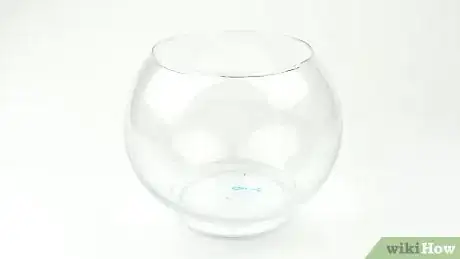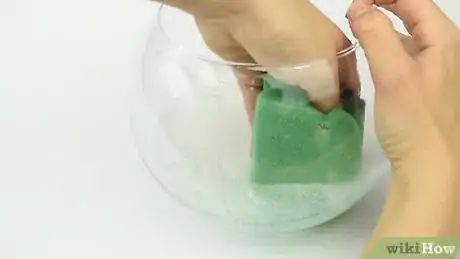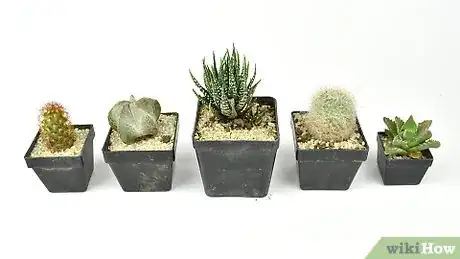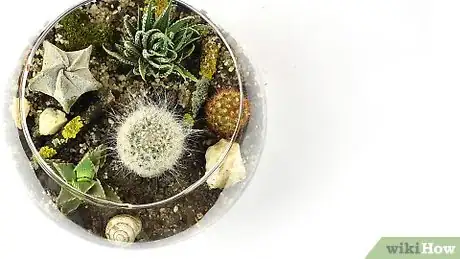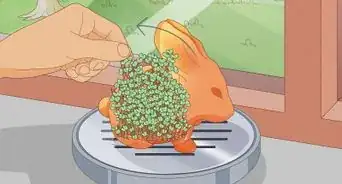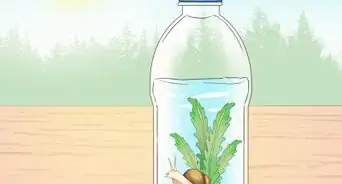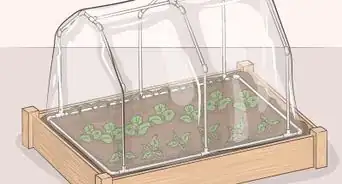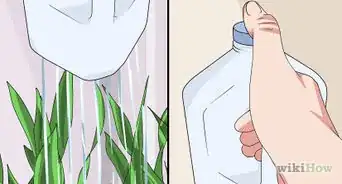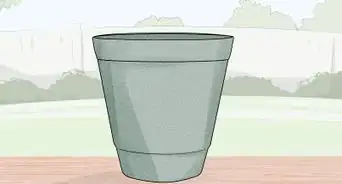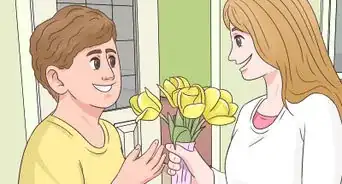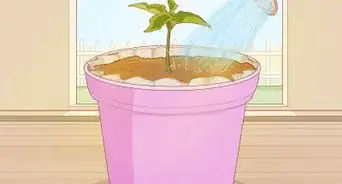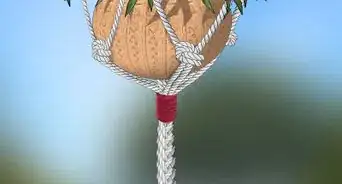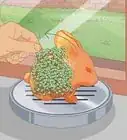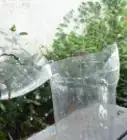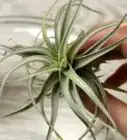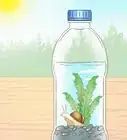This article was co-authored by Joy Cho. Joy Cho is the Founder and Creative Director of the lifestyle brand and design studio, Oh Joy!, founded in 2005 and based in Los Angeles, California. She has authored six books and consulted for creative businesses around the world. Joy has lectured on business, leadership, and entrepreneurship at conferences and companies such as AltSummit, Pinterest, Target, and Hallmark, while her home and studio have been featured in magazines such as House Beautiful, Parents, and Domino. She has also been named one of Time's 30 Most Influential People on the Internet multiple times and has the most followed account on Pinterest with more than 14 million followers.
There are 7 references cited in this article, which can be found at the bottom of the page.
This article has been viewed 55,694 times.
Making a terrarium can be cheap and easy. If you have a clear glass container, gravel, gardening charcoal, soil, and small plants, you have all the ingredients you need to get started. A terrarium can be as inexpensive to create as the soil and plants you choose. Putting together a terrarium is a quick and affordable way to liven up any indoor space!
Steps
Creating the Base
-
1Reuse a glass jar, bowl, or other clear container for the enclosure. For a cheap terrarium, you can use an old glass jar, an old fishbowl, or even a clear coffee pot! Any glass container can work as a terrarium.[1]
- For a closed terrarium, you’ll want to use a container with a sealable lid.
- An old mason jar is a great container to use if you’re making your first terrarium.
- For a miniature terrarium, you could use a small jelly jar.
-
2Wash the container with anti-bacterial soap. After selecting your clear container, you’ll want to make sure it’s clean. Wash it with an anti-bacterial soap, and then rinse and dry the container thoroughly.[2]Advertisement
-
3Layer the container’s bottom with gravel from your driveway. Now that your terrarium container is nice and clean, you’ll want to fill its bottom with gravel. You can collect this gravel from your driveway or somewhere else outside for free. Make this bottom layer about 1⁄2 inch (13 mm) deep.[3]
- You can substitute sand from the beach for gravel in this step.
- This bottom level of gravel or sand will let water drain away from your plants, which will prevent their roots from rotting.
-
4Add a thin layer of crushed gardening charcoal. Once you’re happy with your bottom layer of gravel or sand, you’ll want to add a thin layer of crushed gardening charcoal. You’ll want to make this second layer about 1⁄4 inch (6.4 mm) deep.[4]
- This layer of charcoal will help dampen any unpleasant smells and limit mold.
- Don’t use charcoal that is meant for your barbeque. This charcoal has added chemicals and is not recommended for use in gardens.[5]
-
5Add good quality soil to the top of your charcoal base. Now that you have your base, you can add your soil. You can use soil from your garden or from a dead potted plant. Layer the top of the charcoal with 4–5 inches (10–13 cm) of soil.[6]
- If you’re using a smaller container and have plants with shorter roots, you should make your soil layer less deep.
- If there’s enough soil to cover your plants’ roots, you should be fine.
Choosing and Adding Plants
-
1Choose cheap and attractive plants of your choice. You can try planting just about anything in your terrarium, as long as it’s small and won’t grow too much. Wild strawberries, violets, small ferns, and other plants that grow well in forest shade are popular options.[7]
-
2Decide where you want to put your plants. In the soil, mark where you want each of your plants to be. Then, gently carve a valley where you plan to put each plant.
- Make sure you leave space between plants so that they have enough room to grow.
-
3Gently remove plants from their containers. Gently take your plants out of their original pots. Try to remove as much of the potting soil from the plant as possible. Leave just the soil that is directly touching the roots.
- Be careful not to damage the roots as you take out your plants.
-
4Position 1 plant in each hole. Next, you’ll want to put your plants in the valleys you dug in the layer of soil. Cover the roots with soil, and pack soil around the plants.
- You’ll want to make sure your plants are stable and can stand up on their own.
Including Low-Cost Accessories
-
1Look outside for interesting stones to add to your terrarium. Now that you’ve finished putting in your plants, it is time to add the landscaping. Small stones are a classic aspect used in most terrarium landscapes, and you can find them for free just about anywhere.
- The shore of a lake, river, or another body of water is an excellent place to find stones in a variety of shapes and colors.
-
2Take moss from a nearby rock or tree and add it to your terrarium. Many terrarium builders use moss to dress the surface of their closed terrariums. Most gardening stores sell moss, but if you’d like to spend even less money on your moss-covered terrarium, why not just head outside and get some for free?[10]
- You can use a trowel to scrape some off a tree, rock, or the ground.
-
3Go into your backyard or local park and collect twigs. Your backyard or local park is a perfect place to find natural goodies to decorate your terrarium. You’ll be surprised how much variety there is just outside your door.
- Pinecones, acorns, and bark are other materials you might consider adding to your terrarium’s landscape.
- If you live near an ocean, you could head to the beach and collect shells to use for decoration.
-
4Add any miniature figurines and other trinkets you have lying around. Adding a figurine or trinket to the inside of your terrarium will give it a unique character. You can choose just about anything to put in your terrarium.[11]
- Add a small animal figurine, miniature statue, colorful marbles, or anything else that catches your eye would work well.
-
5Care for your terrarium with water and indirect sunlight. Terrariums are very low maintenance. Add a little water and place your terrarium in a location will it will receive indirect sunlight.[12]
- A closed terrarium should flourish without watering, but you may need to help out your plants with an occasional misting.[13]
- Be careful not to overwater your open terrarium. You’ll need to add water only when the soil gets dry.
Expert Q&A
Did you know you can get expert answers for this article?
Unlock expert answers by supporting wikiHow
-
QuestionHow do you start a terrarium?
 Joy ChoJoy Cho is the Founder and Creative Director of the lifestyle brand and design studio, Oh Joy!, founded in 2005 and based in Los Angeles, California. She has authored six books and consulted for creative businesses around the world. Joy has lectured on business, leadership, and entrepreneurship at conferences and companies such as AltSummit, Pinterest, Target, and Hallmark, while her home and studio have been featured in magazines such as House Beautiful, Parents, and Domino. She has also been named one of Time's 30 Most Influential People on the Internet multiple times and has the most followed account on Pinterest with more than 14 million followers.
Joy ChoJoy Cho is the Founder and Creative Director of the lifestyle brand and design studio, Oh Joy!, founded in 2005 and based in Los Angeles, California. She has authored six books and consulted for creative businesses around the world. Joy has lectured on business, leadership, and entrepreneurship at conferences and companies such as AltSummit, Pinterest, Target, and Hallmark, while her home and studio have been featured in magazines such as House Beautiful, Parents, and Domino. She has also been named one of Time's 30 Most Influential People on the Internet multiple times and has the most followed account on Pinterest with more than 14 million followers.
Designer & Style Expert, Oh Joy!
-
QuestionCan I use fake plants?
 ChristyCommunity AnswerYes, you can. If you don't want to have to do upkeep on your terrarium, or you prefer fake plants for any other reason, go ahead and use them!
ChristyCommunity AnswerYes, you can. If you don't want to have to do upkeep on your terrarium, or you prefer fake plants for any other reason, go ahead and use them! -
QuestionHow do I remove and plant a very pointy cactus?
 ChristyCommunity AnswerTry gently wrapping a paper towel or piece of paper around the cactus to move it, then remove the paper when you're finished.
ChristyCommunity AnswerTry gently wrapping a paper towel or piece of paper around the cactus to move it, then remove the paper when you're finished.
Things You’ll Need
- Clear container
- A small bag of gardening charcoal (available at gardening stores)
- A small bag of gardening soil
- Gravel or sand
- Various plants
- Decorations of your choice
- Watering can
- Anti-bacterial soap
References
- ↑ https://climatekids.nasa.gov/mini-garden/
- ↑ https://www.librarypoint.org/blogs/post/terrariums/
- ↑ https://www.librarypoint.org/blogs/post/terrariums/
- ↑ https://www.librarypoint.org/blogs/post/terrariums/
- ↑ https://homeguides.sfgate.com/improve-garden-soil-charcoal-21913.html
- ↑ https://www.librarypoint.org/blogs/post/terrariums/
- ↑ https://www.librarypoint.org/blogs/post/terrariums/
- ↑ https://gardenerspath.com/how-to/containers/terrariums-mini-landscapes/
- ↑ https://gardenerspath.com/how-to/containers/terrariums-mini-landscapes/
About This Article
You can easily make a cheap terrarium by reusing an old fishbowl, a large glass jar, or even a clear coffee pot as an enclosure. Before you put anything in your enclosure, wash it with antibacterial soap and dry it thoroughly so it is nice and clean for your plants. Once the glass is clean, layer the bottom with a ½ inch of gravel from your driveway or sand from a beach to allow excess water to drain and prevent your plants’ roots from rotting. Once you’re happy with your bottom layer, add a ¼ inch of crushed gardening charcoal to dampen any smells and reduce mold. Make sure to avoid using charcoal that’s meant for barbecues, since that has added chemicals which can harm your plants. Finally, add 4 to 5 inches of soil and a few of your favorite plants. For more advice, including how to care for your terrarium, read on!
